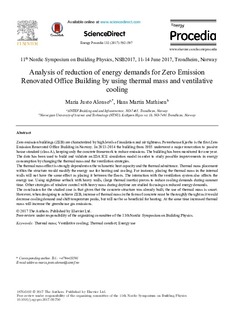| dc.contributor.author | Alonso, Maria Justo | |
| dc.contributor.author | Mathisen, Hans Martin | |
| dc.date.accessioned | 2017-11-28T07:16:55Z | |
| dc.date.available | 2017-11-28T07:16:55Z | |
| dc.date.created | 2017-11-27T09:34:41Z | |
| dc.date.issued | 2017 | |
| dc.identifier.citation | Energy Procedia. 2017, 132 592-597. | nb_NO |
| dc.identifier.issn | 1876-6102 | |
| dc.identifier.uri | http://hdl.handle.net/11250/2468189 | |
| dc.description.abstract | Zero emission buildings (ZEB) are characterized by high levels of insulation and air tightness. Powerhouse Kjørbo is the first Zero Emission Renovated Office Building in Norway. In 2013-2014 the building from 1985 underwent a major renovation to passive house standard (class A), keeping only the concrete framework to reduce emissions. The building has been monitored for one year. The data has been used to build and validate an IDA ICE simulation model in order to study possible improvements in energy consumption by changing the thermal mass and the ventilation strategies. The thermal mass effect is strongly dependent on the volumetric heat capacity and the thermal admittance. Thermal mass placement within the structure would modify the energy use for heating and cooling. For instance, placing the thermal mass in the internal walls will not have the same effect as placing it between the floors. The interaction with the ventilation system also affects the energy use. Using nighttime setback with heavy walls, (large thermal inertia) proves to reduce cooling demands during summer time. Other strategies of window control with heavy mass during daytime are studied focusing on reduced energy demands. The conclusion for the studied case is that given that the concrete structure was already built, the use of thermal mass is smart. However, when designing to achieve ZEB, increase of thermal mass in the form of concrete must be thoroughly thought as it would decrease cooling demand and shift temperature peaks, but will not be so beneficial for heating. At the same time increased thermal mass will increase the greenhouse gas emissions | en |
| dc.description.sponsorship | Acknowledgment. This work has been supported by the Research Council of Norway and several partners through the SINTEF/NTNU “The research centre of Zero Emissions Buildings” (ZEB). Grant number 193830. | en |
| dc.language.iso | eng | nb_NO |
| dc.publisher | Elsevier Ltd. | nb_NO |
| dc.rights | Attribution-NonCommercial-NoDerivatives 4.0 Internasjonal | * |
| dc.rights.uri | http://creativecommons.org/licenses/by-nc-nd/4.0/deed.no | * |
| dc.subject | Energy use | en |
| dc.subject | Heating and cooling | en |
| dc.subject | Thermal admittance | en |
| dc.subject | Thermal mass | en |
| dc.subject | Ventilation strategy | en |
| dc.subject | Ventilation systems | en |
| dc.subject | Volumetric heat capacity | en |
| dc.subject | Zero emission buildings | nb_NO |
| dc.title | Analysis of reduction of energy demands for Zero Emission Renovated Office Building by using thermal mass and ventilative cooling | en |
| dc.title.alternative | Nordic Symposium on Building Physics, NSB 2017, June 11, 2017 | en |
| dc.type | Journal article | nb_NO |
| dc.type | Peer reviewed | nb_NO |
| dc.description.version | publishedVersion | nb_NO |
| dc.rights.holder | © The authors | nb_NO |
| dc.subject.nsi | VDP::Technology: 500 | en |
| dc.source.pagenumber | 592-597 | nb_NO |
| dc.source.volume | 132 | nb_NO |
| dc.source.journal | Energy Procedia | nb_NO |
| dc.identifier.doi | 10.1016/j.egypro.2017.09.750 | |
| dc.identifier.cristin | 1518660 | |
| dc.relation.project | Norges forskningsråd: 193830 | nb_NO |
| cristin.unitcode | 7401,30,40,0 | |
| cristin.unitname | Arkitektur, byggematerialer og konstruksjoner | |
| cristin.ispublished | true | |
| cristin.fulltext | original | |
| cristin.qualitycode | 1 | |

